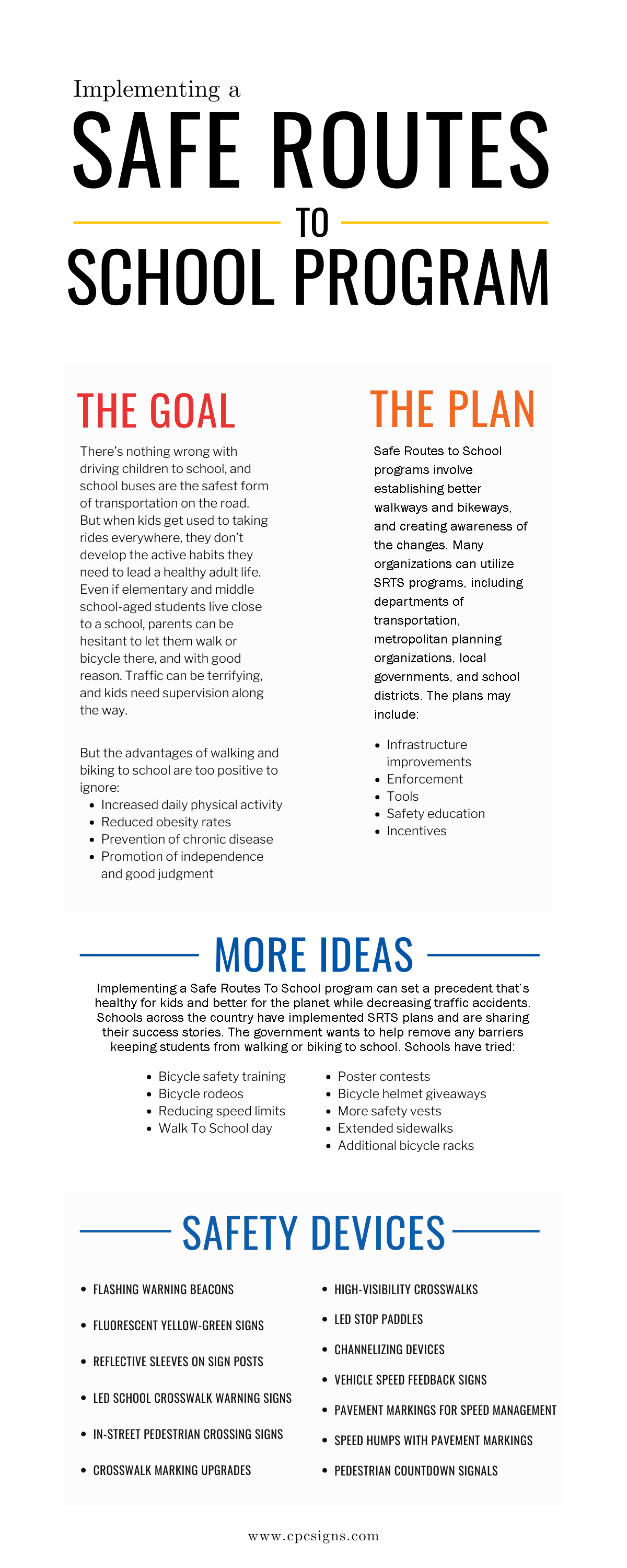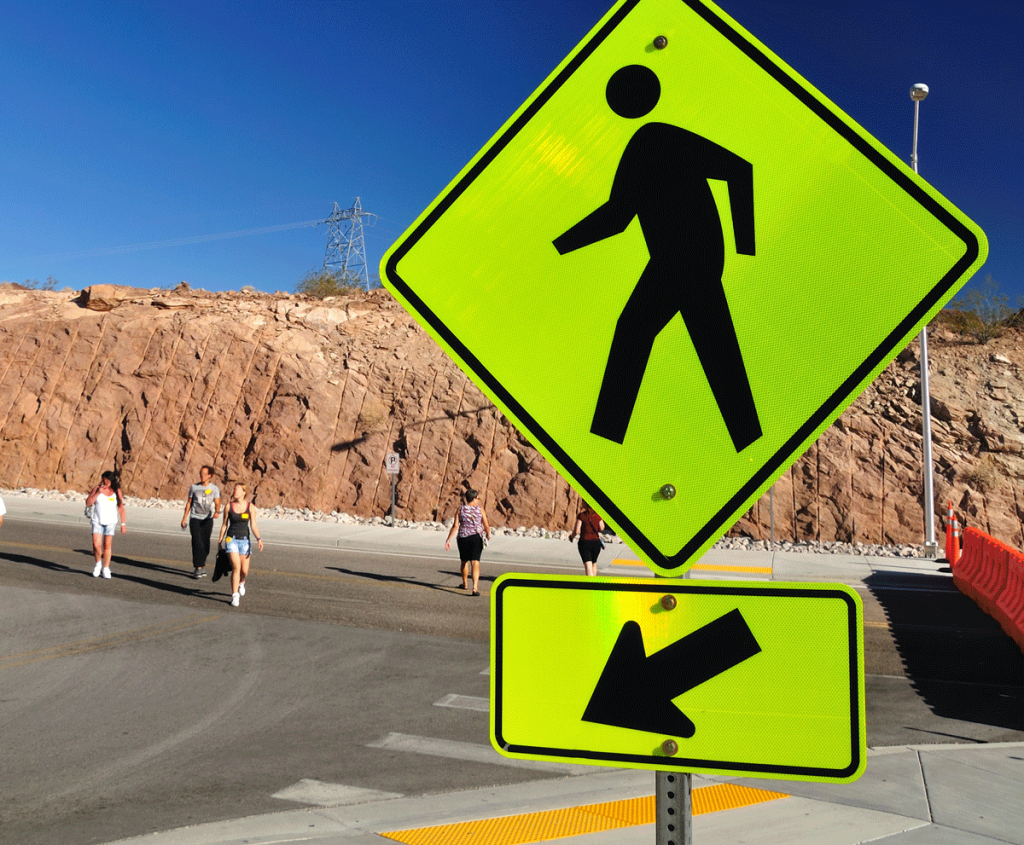Encouraging children to walk or bike to school can have benefits for the rest of their lives. Parents may have concerns, but implementing a Safe Routes to School program is a smart choice.
The Goal
There’s nothing wrong with driving children to school, and school buses are the safest form of transportation on the road. But when kids get used to taking rides everywhere, they don’t develop the active habits they need to lead a healthy adult life. Even if elementary and middle school-aged students live close to a school, parents can be hesitant to let them walk or bicycle there, and with good reason. Traffic can be terrifying, and kids need supervision along the way.
But the advantages of walking and biking to school are too positive to ignore:
- Increased daily physical activity
- Reduced obesity rates
- Prevention of chronic disease
- Promotion of independence and good judgment
Using fewer cars and buses has benefits for the planet, too. It reduces fuel consumption as well as emissions that pollute the air. Safe Routes to School efforts ease traffic congestion and can avert many motor vehicle-related injuries and fatalities.
The Plan
Safe Routes to School programs involve establishing better walkways and bikeways, and creating awareness of the changes. Many organizations can utilize SRTS programs, including departments of transportation, metropolitan planning organizations, local governments, and school districts. The plans may include:
- Infrastructure improvements
- Enforcement
- Tools
- Safety education
- Incentives
Safety Devices
Flashing Warning Beacons
SRTS plans may include new equipment and devices that keep kids safe on their way to school. For instance, passing drivers are less likely to miss school zone signs that feature flashing warning beacons. It’s a measure that prioritizes pedestrians on their way to school and keeps them safe.
Fluorescent Yellow-Green Signs
The Manual for Uniform Traffic Control Devices requires that school zone safety signsbe fluorescent yellow-green. Fluorescent yellow-green is required because it’s more conspicuous than standard yellow, especially in dim light and inclement weather. Also, that color indicates pedestrians, people in the roadway, and has no other use in signage. When drivers can see signs from a greater distance, they have more time to slow down and avoid collisions.
Reflective Brite-Max Reflectors on Sign Posts
You can enhance the conspicuity of signs with fluorescent and reflective Brite-Max reflectors —panels of reflective sheeting that attach to signposts. Converting the post area into a fluorescent and reflective surface can help alert drivers to school zones and crosswalk warnings.
LED School Crosswalk Warning Signs
People can enhance a typical school crosswalk warning sign by adding flashing LED lights around the sign’s edge. They make the sign visible from a greater range and help drivers identify the sign’s pentagon “schoolhouse” shape. Plus, you can install solar or battery-powered LED lights at a smaller cost than a permanent electrical device.
In-Street Pedestrian Crossing Signs
These signs are placed in the street at unmarked pedestrian crossings with limits of 30 miles per hour or less. They remind drivers to yield to pedestrians in school zones.
Crosswalk Marking Upgrades
Standard crosswalk markings consist of two solid white transverse lines perpendicular to traffic. They define paths for students to take when crossing the road, and alert drivers of the presence of pedestrians. The crosswalks thus become much more noticeable.
High-Visibility Crosswalks
These are standard transverse crosswalk markings with colored pavement (preferably fluorescent yellow-green) between the crosswalk lines. It emphasizes the crosswalk for both students and drivers.
High-Visibility Garments
When you’re adding crossing guards to your Safe Routes To School plan, don’t forget to provide them with protection. Class 2 high-visibility vests are the minimum requirement for anyone working near traffic.
Channelizing Devices
These devices warn, alert, and guide drivers while separating pedestrian and bicycle paths from traffic. They can also restrict vehicular movements that endanger students. These devices include:
- Cones
- Tubular markers
- Vertical panels
- Drums
- Barricades
- Temporary raised islands
Vehicle Speed Feedback Signs
Feedback signs use radar to measure and record the speed of passing vehicles and display it to approaching drivers. When used in conjunction with school zone speed limit signs, drivers have an additional warning to slow down. Typically, they reduce driver speeds by 10 miles per hour.
Pavement Markings for Speed Management
These visual indicators warn drivers to slow down with different patterns, such as:
Typically, they reduce driver speeds by five miles per hour.
Speed Humps With Pavement Markings
While speed bumps are more abrupt, speed humps are 12 to 14 feet long and three to four inches high. That makes the rise and fall of the pavement more gradual. They’re indicated with white paint markings and are often used with crosswalks.
Pedestrian Countdown Signals
Between the “walk” and “don’t walk” signals, a countdown clock shows a pedestrian how long they have to proceed across a crosswalk. Students can judge whether they’ll have enough time to cross or if they should wait for the next light.
More Ideas
Implementing a Safe Routes To School program can set a precedent that’s healthy for kids and better for the planet while decreasing traffic accidents. Schools across the country have implemented SRTS plans and are sharing their success stories. The government wants to help remove any barriers keeping students from walking or biking to school. Schools have tried:
The Alpine Elementary School in Utah combined the SRTS program with an emphasis on better nutrition, partnering with a sister school in Kenya. Other schools have found that “walking school buses” are popular: a group of students walks to school together with adults to supervise. And some of the best ideas are coming from kids.
If you’re looking for ideas about how to make your school district more active, give Custom Products Corporation a call. We manufacture and sell all of these devices and more, and have been making streets and roads safer since 1985.

- Narrow travel lane markings
- Optical speed bars
- Converging chevrons
- Bicycle safety training
- Bicycle rodeos
- Reducing speed limits
- Walk To School day
- Poster contests
- Bicycle helmet giveaways
- More safety vests
- Extended sidewalks
- Additional bicycle racks




